
A nickel–metal hydride battery is a type of rechargeable battery. The chemical reaction at the positive electrode is similar to that of the nickel-cadmium cell (NiCd), with both using nickel oxide hydroxide (NiOOH). However, the negative electrodes use a hydrogen-absorbing alloy instead of cadmium. NiMH batteries can have two to three times the capacity of NiCd batteries of the same size, with significantly higher energy density, although only about half that of lithium-ion batteries.

The nickel–cadmium battery is a type of rechargeable battery using nickel oxide hydroxide and metallic cadmium as electrodes. The abbreviation Ni–Cd is derived from the chemical symbols of nickel (Ni) and cadmium (Cd): the abbreviation NiCad is a registered trademark of SAFT Corporation, although this brand name is commonly used to describe all Ni–Cd batteries.
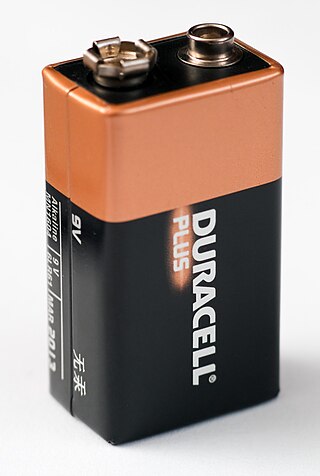
Duracell Inc. is an American manufacturer of alkaline batteries, specialty cells, and rechargeables; it is a wholly owned subsidiary of Berkshire Hathaway. The company has its origins in the 1920s, through the work of Samuel Ruben and Philip Mallory, and the formation of the P. R. Mallory Company.

An alkaline battery is a type of primary battery where the electrolyte has a pH value above 7. Typically these batteries derive energy from the reaction between zinc metal and manganese dioxide.
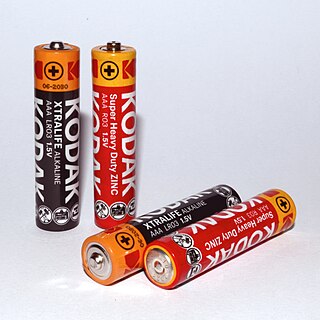
The AAA battery is a standard size of dry cell battery. One or more AAA batteries are commonly used in low-drain portable electronic devices. A zinc–carbon battery in this size is designated by IEC as R03, by ANSI C18.1 as 24, by old JIS standard as UM-4, and by other manufacturer and national standard designations that vary depending on the cell chemistry. The size was first introduced by The American Ever Ready Company in 1911. They're called #7 batteries in China, the name originating from the Burgess Battery Company designating his AAA batteries "Number 7".
A primary battery or primary cell is a battery that is designed to be used once and discarded, and not recharged with electricity and reused like a secondary cell. In general, the electrochemical reaction occurring in the cell is not reversible, rendering the cell unrechargeable. As a primary cell is used, chemical reactions in the battery use up the chemicals that generate the power; when they are gone, the battery stops producing electricity. In contrast, in a secondary cell, the reaction can be reversed by running a current into the cell with a battery charger to recharge it, regenerating the chemical reactants. Primary cells are made in a range of standard sizes to power small household appliances such as flashlights and portable radios.

The AA battery is a standard size single cell cylindrical dry battery. The IEC 60086 system calls the size R6, and ANSI C18 calls it 15. It is named UM-3 by JIS of Japan. Historically, it is known as D14, U12 – later U7, or HP7 in official documentation in the United Kingdom, or a pen cell.
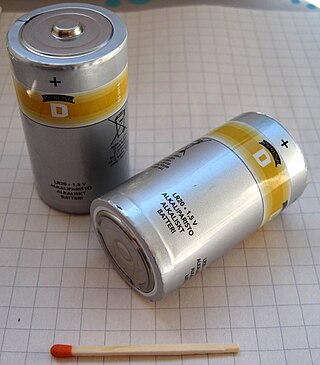
A D battery is a standardized size of a dry cell. A D cell is cylindrical with an electrical contact at each end; the positive end has a nub or bump. D cells are typically used in high current drain applications, such as in large flashlights, radio receivers, and transmitters, and other devices that require an extended running time. A D cell may be either rechargeable or non-rechargeable. Its terminal voltage and capacity depend upon its cell chemistry.

The nine-volt battery, or 9-volt battery, is an electric battery that supplies a nominal voltage of 9 volts. Actual voltage measures 7.2 to 9.6 volts, depending on battery chemistry. Batteries of various sizes and capacities are manufactured; a very common size is known as PP3, introduced for early transistor radios. The PP3 has a rectangular prism shape with rounded edges and two polarized snap connectors on the top. This type is commonly used for many applications including household uses such as smoke and gas detectors, clocks, and toys.

A rechargeable alkaline battery, also known as alkaline rechargeable or rechargeable alkaline manganese (RAM), is a type of alkaline battery that is capable of recharging for repeated use. The formats include AAA, AA, C, D, and snap-on 9-volt batteries. Rechargeable alkaline batteries are manufactured fully charged and have the ability to hold their charge for years, longer than nickel-cadmium and nickel-metal hydride batteries, which self-discharge. Rechargeable alkaline batteries can have a high recharging efficiency and have less environmental impact than disposable cells.
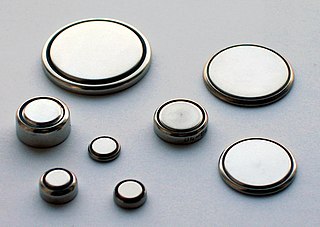
A button cell, watch battery, or coin battery is a small single-cell battery shaped as a squat cylinder typically 5 to 25 mm in diameter and 1 to 6 mm high – resembling a button. Stainless steel usually forms the bottom body and positive terminal of the cell; insulated from it, the metallic top cap forms the negative terminal.
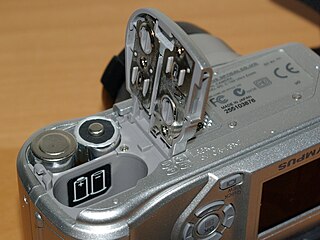
A CR-V3 battery is a type of disposable high-capacity 3-volt battery used in various electronic appliances, including some digital cameras. It has the shape and size of two side-by-side AA batteries. This allows CR-V3 batteries to function in many devices originally designed for only AA batteries. An RCR-V3 battery is a rechargeable 3.7 V lithium-ion battery.

The AAAA battery is 42.5 mm long and 8.3 mm in diameter. The alkaline cell weighs around 6.5 g and produces 1.5 V. This size battery is also classified as R8D425 (IEC) and 25 (ANSI/NEDA). The alkaline battery in this size is also known by Duracell type number MN2500 or MX2500 and Energizer type number E96.
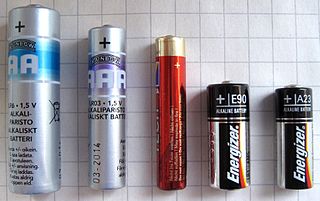
The A23 battery is a dry battery consisting of eight LR932 cells, with a nominal voltage of 12 V.

Eneloop is a brand of 1.2-volt low self-discharge nickel–metal hydride (NiMH) rechargeable batteries and accessories developed by Sanyo and introduced in 2005. Panasonic acquired a majority stake in Sanyo in 2009, and Eneloop batteries were thereafter branded, but not manufactured, by Panasonic.

An electric battery is a source of electric power consisting of one or more electrochemical cells with external connections for powering electrical devices. When a battery is supplying power, its positive terminal is the cathode and its negative terminal is the anode. The terminal marked negative is the source of electrons that will flow through an external electric circuit to the positive terminal. When a battery is connected to an external electric load, a redox reaction converts high-energy reactants to lower-energy products, and the free-energy difference is delivered to the external circuit as electrical energy. Historically the term "battery" specifically referred to a device composed of multiple cells; however, the usage has evolved to include devices composed of a single cell.
Standard battery nomenclature describes portable dry cell batteries that have physical dimensions and electrical characteristics interchangeable between manufacturers. The long history of disposable dry cells means that many manufacturer-specific and national standards were used to designate sizes, long before international standards were reached. Technical standards for battery sizes and types are set by standards organizations such as International Electrotechnical Commission (IEC) and American National Standards Institute (ANSI). Popular sizes are still referred to by old standard or manufacturer designations, and some non-systematic designations have been included in current international standards due to wide use.

An N battery is a standard size of dry-cell battery. An N battery is cylindrical with electrical contacts on each end; the positive end has a bump on the top. The battery has a length of 30.2 mm (1.19 in) and a diameter of 12.0 mm (0.47 in), and is approximately three-fifths the length of a AA battery.
This is a list of commercially-available battery types summarizing some of their characteristics for ready comparison.
















